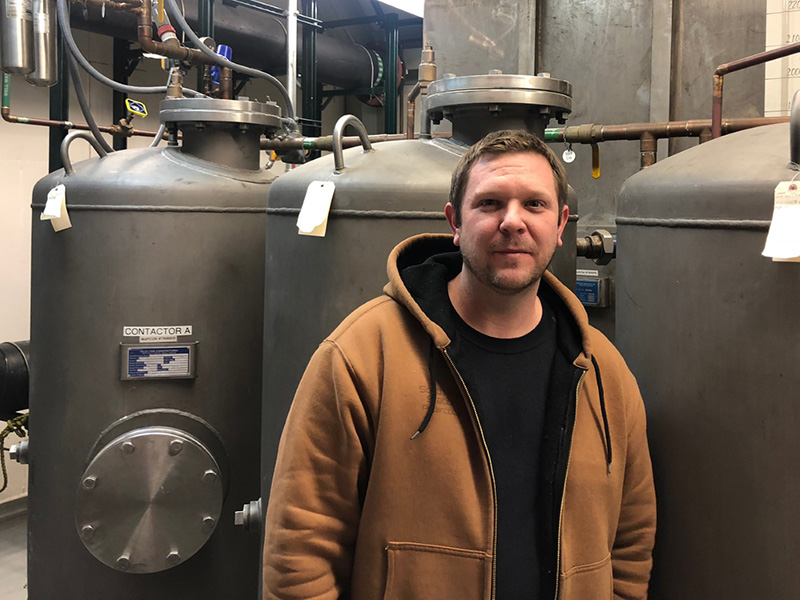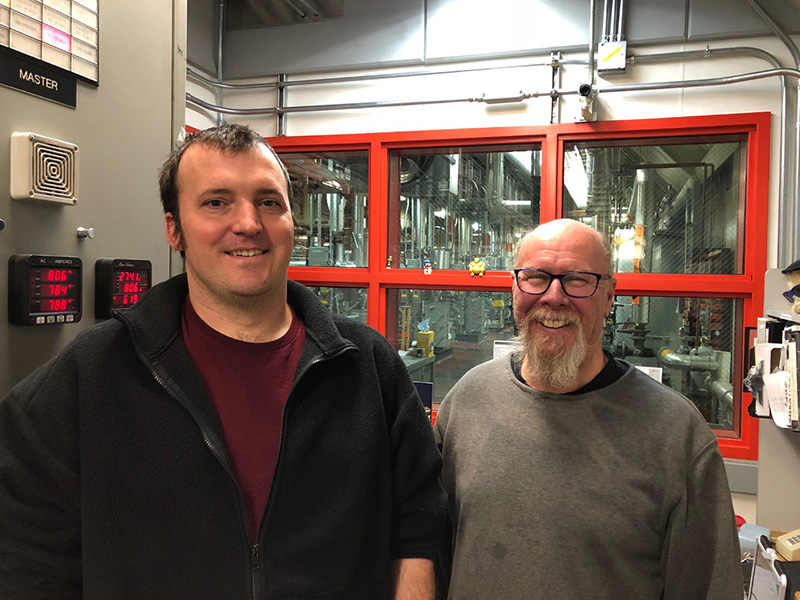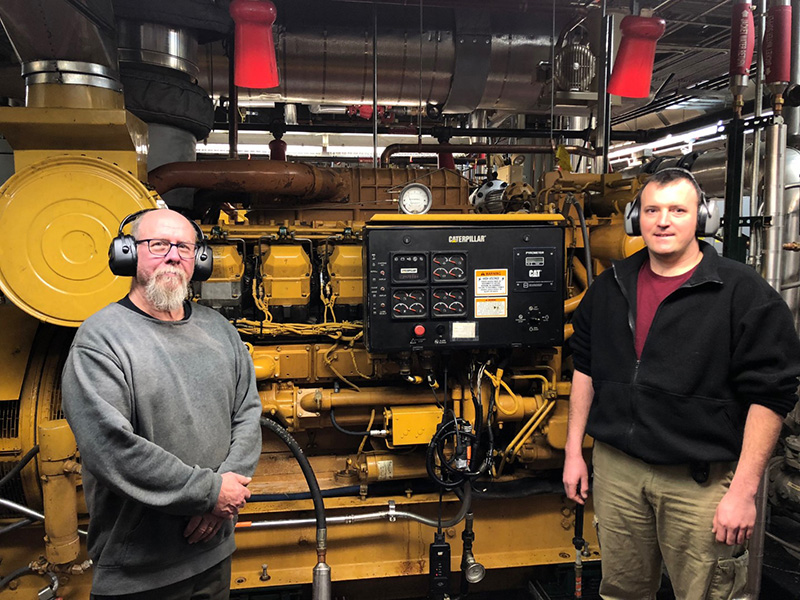Snow Juice
By Mike Legatt, South Pole Correspondent
July 15, 2019

Photo Credit: Mike Legatt
Michael McClure is the water-quality specialist at the Amundsen-Scott South Pole Station.
Most people have never heard of "Snow Juice." That's because it's a term coined by Michael McClure to describe water. He's the South Pole's water-quality specialist and unofficially, its chief comedian. The Snow Juice tastes fresh here, so I asked him to give me some background on our setup.
With the South Pole station built on top of an almost two-mile-thick ice sheet, it might seem like melting the surrounding snow would be the simplest way to get potable water, but it's not that easy. Yes, the frozen water is incredibly pure here with low dissolved solids, low calcium and low pH, but this makes it ironically weak and if left untreated it would have an increased ability to corrode pipes. Though it might taste fine, as it passes through your body there would be a greater tendency for it to leach minerals and nutrients away from you, requiring even more care to maintain a healthy diet. Using limestone minerals and other chemical additives, Michael is able to harden the water enough to make it more potable and less corrosive.
We get our liquid water from the station's "Rodwell" which is short for "Rodriguez Well," named after Army engineer Raul Rodriguez who developed this technique for getting water at the opposite end of the world, in Greenland. During the Cold War in the 1960s, the United States Army constructed the nuclear-powered Camp Century under the ice in northern Greenland to study feasibility of living within the ice sheet. That study was designed to be part of a soon-cancelled project to build larger outposts under the ice sheet. There, they created an artificial aquifer by melting a large bulb of water under the ice sheet to get usable liquid water. That original concept pioneered at Camp Century decades ago is the same used at the South Pole today.
The entire station uses roughly 1,000 gallons every day, which according to Michael is "very efficient." With a volume of roughly three million gallons of volume in the Rodwell, it takes weeks to recycle all the water in the bulb through the station. Since the snow here is so pure, anything in it that isn't ice sticks out like a sore thumb. The Rodwell has even been used in past studies to extract meteorites (think pool-cleaner machine).
Michael is no stranger to extreme conditions. He joined the infantry the day after he turned 18. After leaving the Army, he studied environmental science before spending two years in a remote part of Malawi in the Peace Corps. In Malawai he did some light water work (his first outside of college environment) focusing mostly on Kasungu National Park projects and community development. He is proud of having constructed a girls' hostel for secondary school students, giving them a place to stay in support of their education. He’s worked in clinics, distributed seeds for farming and can speak Chichewa. Later, he worked in Colorado as an environmental protection specialist, before working as a water quality specialist.
He first got interested in joining the U.S. Antarctic Program after watching the Antarctic episode of Anthony Bourdain's Parts Unknown. He did some research to understand how the South Pole water system operates, and ultimately landed this job. After this season he’s thinking about visiting the South Pacific.
Turnin 'n Burnin
By Mike Legatt, South Pole Correspondent
June 12, 2019

Photo Credit: Mike Legatt
Miles (left) and Dennis run the power station at Amundsen-Scott South Pole Station.

Photo Credit: Mike Legatt
Dennis (left) and Miles stand in front of one of the generators they maintain that power the station.
Meet Miles Allen and Dennis Calhoun. Together, they're in charge of the station's power plant. Just about everything at the South Pole, from food preparation and water production to satellite communications and operation of the telescopes, relies on their expertise, vigilance and reliability. These two polies, along with the help of water technician Michael McClure, run the power plant 24 hours a day, seven days a week, in the most remote place on Earth.
Conditions here are extreme. Step outside carelessly in the winter and frostbite can happen in less than five minutes. It's so cold your eyelashes can freeze shut. Power is essential to life in this harsh environment. Without it, an otherwise normal day in Antarctica would quickly turn into a life-threatening emergency. One bad decision or unlucky turn and the cold will quickly cause mayhem. Water supplies could freeze, pipes could burst, and anything moving could freeze solid. That’s where the plant comes into play to keep everything powered up and heated.
With four diesel engines and two emergency engines to troubleshoot, repair and maintain, there is always something going on in the power plant. Oil changes and regular maintenance are ongoing, but sometimes unexpected diagnoses and repairs crop up. One of the motors' twelve massive cylinders may need a rebuild, or maybe there is a slight change in engine sound, something nearly imperceptible to just about everyone else, indicating a pending failure in need of immediate attention. Step one foot inside the power plant and it’s obvious that Miles and Dennis put great pride into keeping the plant spotless and organized.
The two of them have a wide range of interests. Miles has traveled more than perhaps anyone else on station, having traveled a vast majority of the 19,000 mile Pan-American Highway from Ushuaia, Argentina to Prudhoe Bay, Alaska and is hoping to complete a circumnavigation of Australia in the future. After graduating from the Great Lakes Maritime Academy, Miles traveled all over the world while working in the Military Sealift Command and the Army Corps of Engineers. He is especially fond of the work he did aboard the hospital ship USNS Comfort during Operation Continuing Promise in Central and South America. Experiencing new cultures and seeing new sights is a passion of his – no surprise for someone who has traveled to all seven continents.
Dennis has lived everywhere from tropical islands in the South Pacific to Michigan to Australia. Before joining the Antarctic Program, he was at Detroit Diesel for 19 years, opened a racing shop, and through the National Hot Rod Association worked on a wheel-driven land speed record holder Goldenrod. After contacting a Pole meteorologist about their blog, he decided Antarctica would be an interesting place to go. Soon, he realized either you like it here or you don't. Nine seasons later he has wintered six times in Antarctica, two of which were under the old dome at South Pole, as well as at Palmer Station and McMurdo. Also a farmer in a previous job, he’s been using that expertise to help to pollinate plants in the station’s greenhouse, leading to a successful cucumber crop. Also as part of the program he’s been a lead pastor, having lead a service after the Columbia disaster in 2003.
Last Rays of the Old Setting Sun
By Ben Eberhardt, South Pole Station correspondent
May 15, 2019

Photo Credit: Benjamin Eberhardt
The drops below the horizon at the South Pole, not to be seen again for six months.

Photo Credit: Luis Gonzalez
The last plane to pass through South Pole dropped off a supply of fresh fruits and vegetables, the last the station will see until November.

Photo Credit: Benjamin Eberhardt
Station residents help to adjust the BICEP3 telescope as winter sets in.
After a busy summer season, the sun has set at South Pole and won't rise again for another six months. As it sank lower in the sky, it grew colder. Much colder. To go outside now, one has to dress up almost like an astronaut in a space suit, with every single bit of skin and eyes covered. Wearing all this, I sometimes feel oddly disconnected from the harsh environment. Only when there is high wind does it find its way through all my many layers, and then I wish I was wearing an actual space suit.
Five days after the solar equinox on March 20, the last refracted sun rays touched the station. With temperatures averaging -60 C and the sky clearing up for sunset, we winterovers were treated to a rare spectacle: A beautiful refractive display called the "green flash." It is caused by the dispersion of the sunlight in the Earth's atmosphere. While these phenomena can happen anywhere, the unique feature of the months-long sunset at the Pole can stretch the flashes into hour-long events.
The communal and culinary highlight was the traditional sunset dinner, followed by a special two day weekend. Usually, we don't get that much time off in a row. The galley crew surpassed themselves and came up with some of the most mouth-watering creations imaginable. The greenhouse harvesting schedule was tweaked accordingly to contribute the largest possible amount of "freshies" for the meal. The community organized an entire day of cooking later that week, as a way of thanking the galley staff and giving them some well-deserved time off for their outstanding work.
Luckily, we still have some of the fresh fruits and vegetables left that were delivered by the last flight weeks ago. Our supply of apples does not seem to running out as quickly as I had feared. That last supply flight was one to remember. Among the tons of supplies and other goodies, it contained three lonely single carrots to add to our carrot supply. For all of us. Properly inventoried. Even after some weeks, this still continues to bring amusement.
For the 42 members of our 2019 winter crew, winter and isolation began five weeks earlier with a different celebration. In mid-February, the remaining Summer personnel left the station on the last LC-130 Hercules flight of the season. Everyone who remains will now be cut off from the rest of the world for eight months. This is the moment that most of us have been waiting for all Summer. After "finally" being alone, we gathered in the gym to continue a South Pole tradition and watch all three versions of "The Thing from Another World" - a movie about an alien invasion of an Antarctic research station. There's nothing better to put yourself in the mood for the long months of darkness and isolation.
As the sun dropped lower and lower, the temperature fell and the shadows have been growing longer until they eventually disappeared and the long winter night began. Our long awaited adventure in the darkness begins!
Station News Home Page










